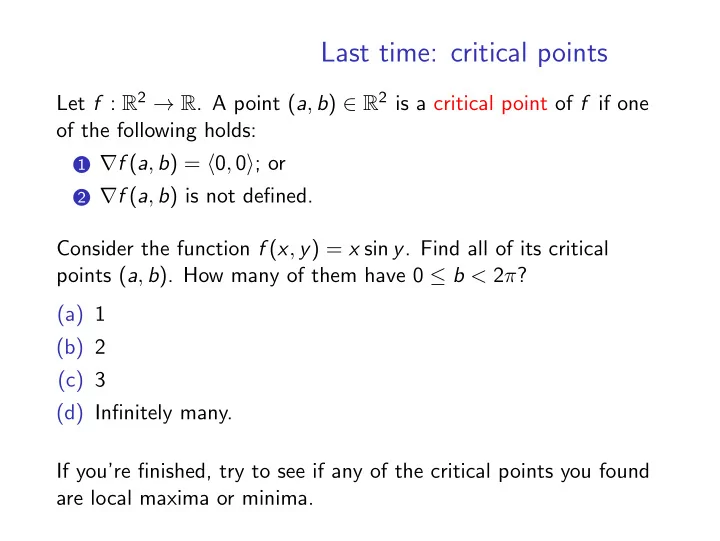

Last time: critical points Let f : R 2 → R . A point ( a , b ) ∈ R 2 is a critical point of f if one of the following holds: 1 ∇ f ( a , b ) = ⟨ 0 , 0 ⟩ ; or 2 ∇ f ( a , b ) is not defined. Consider the function f ( x , y ) = x sin y . Find all of its critical points ( a , b ). How many of them have 0 ≤ b < 2 𝜌 ? (a) 1 (b) 2 (c) 3 (d) Infinitely many. If you’re finished, try to see if any of the critical points you found are local maxima or minima.
Announcements ∙ Midterm 1 graded and returned. Requests for regrade should be submitted in writing to your section TA, who will refer your question to the TA who graded that specific question. ∙ Homework deadline is at 8am. It will be strict starting next Monday! ∙ Please register your i-clicker. If you don’t see your scores on Moodle, send me an email with your name, your UIN, and your i-clicker registration number.
Local maximum/minimum Fix f : R 2 → R , not necessarily differentiable; fix ( a , b ) ∈ R 2 . ∙ We say f has a local maximum at ( a , b ) if f ( a , b ) ≥ f ( x , y ) for all ( y , x ) near ( a , b ). ∙ We say f has a local minimum at ( a , b ) if f ( a , b ) ≤ f ( x , y ) for all ( y , x ) near ( a , b ). Here “near ( a , b )” means “for all ( x , y ) contained in a small disk of radius 𝜗 around the point ( a , b )”. ( 𝜗 can be very small!)
Practice with the second derivative test Recall the function f ( x , y ) = x sin y . The point (0 , 𝜌 ) is a critical point. Find D . (a) D = 0 (b) D = 1 (c) D = -1 (d) I don’t know what to do.
Second derivative test 1 D > 0 , f xx ( a , b ) > 0 ⇒ local minimum at ( a , b ). 2 D > 0 , f xx ( a , b ) < 0 ⇒ local maximum at ( a , b ). 3 D < 0 ⇒ saddle point at ( a , b ).
Recommend
More recommend